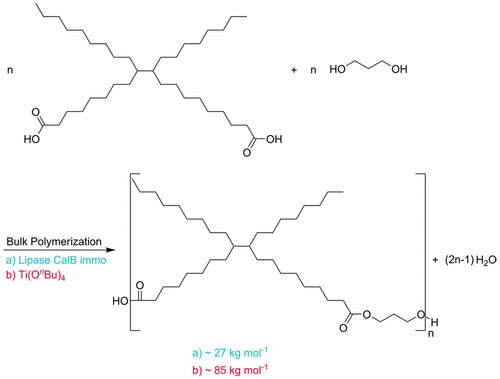当前位置:
X-MOL 学术
›
Org. Process Res. Dev.
›
论文详情
Our official English website, www.x-mol.net, welcomes your feedback! (Note: you will need to create a separate account there.)
Enzyme- and Metal-Catalyzed Synthesis of a New Biobased Polyester
Organic Process Research & Development ( IF 3.4 ) Pub Date : 2017-08-09 00:00:00 , DOI: 10.1021/acs.oprd.6b00418 Jakob Gebhard 1 , Björn Neuer 2 , Gerrit A. Luinstra 2 , Andreas Liese 1
Organic Process Research & Development ( IF 3.4 ) Pub Date : 2017-08-09 00:00:00 , DOI: 10.1021/acs.oprd.6b00418 Jakob Gebhard 1 , Björn Neuer 2 , Gerrit A. Luinstra 2 , Andreas Liese 1
Affiliation

|
Linear aliphatic polyesters were prepared from Pripol 1012, a diacidic C18 fatty acid dimer, and 1,3-propanediol employing a lipase or a titanium tetrabutanoate. Metal-based catalysis (route M) was carried out with a precondensation at 180 °C and 600 mbar followed by a final condensation at 220 °C and 0.3–0.6 mbar. Enzyme catalysis was carried out with an immobilized Candida antarctica lipase B after either a precondensation step at 180 °C and 600 mbar (route E1) or 80 °C and 100 mbar (route E2) and a final condensation at 80 °C and 0.3–0.6 mbar. Polyesters were obtained along routes M, E1, and E2 with weight-average molecular weights, Mw, at final conversion of 84.6, 26.7, and 15.6 kg mol–1, respectively. The final molecular weight via route E2 was most probably constrained by depletion of 1,3-propanediol during precondensation. Rheological measurements of the polyesters in melt revealed a Newtonian-like behavior at 80 °C. The dynamic viscosities fulfill the Cox–Merz rule. The power law for the viscosity as a function of Mw possesses an exponent of 3.7 ± 0.2. A polyesterdiol of Mn ≈ 6 kDa prepared along route M was used in the synthesis of a polyurethane elastomer with a Young modulus of 2.5 MPa, an elongation at break of 554%, an ultimate tensile strength of 3.5 MPa, and a Shore A hardness of 38.
中文翻译:

酶和金属催化合成新型生物基聚酯
线性脂族聚酯由Pripol 1012,二酸C18脂肪酸二聚体和1,3-丙二醇采用脂肪酶或四丁酸钛制备。基于金属的催化(路线M)在180°C和600 mbar下进行预缩合,然后在220°C和0.3-0.6 mbar下进行最终缩合。酶催化用的固定化进行南极假丝酵母或者在180℃和600毫巴(路线E1)或80℃和100毫巴(路线E2),并在80℃和0.3〜最终缩合初期缩合步骤之后脂肪酶B 0.6毫巴 沿路线M,E1和E2获得聚酯,其重均分子量M w为84.6、26.7和15.6 kg mol –1的最终转化率, 分别。通过路线E2的最终分子量很可能受到预缩合过程中1,3-丙二醇消耗的限制。聚酯在熔体中的流变学测量表明,在80°C时,其表现出类似牛顿的行为。动态粘度满足Cox–Merz规则。粘度随M w的幂定律的指数为3.7±0.2。的聚酯二醇中号Ñ ≈6kDa的制备沿着路线中号是与2.5兆帕,在554%的断裂伸长率,3.5兆帕的极限拉伸强度的杨氏模量的聚氨酯弹性体的合成中使用,和肖氏A硬度的38。
更新日期:2017-08-09
中文翻译:

酶和金属催化合成新型生物基聚酯
线性脂族聚酯由Pripol 1012,二酸C18脂肪酸二聚体和1,3-丙二醇采用脂肪酶或四丁酸钛制备。基于金属的催化(路线M)在180°C和600 mbar下进行预缩合,然后在220°C和0.3-0.6 mbar下进行最终缩合。酶催化用的固定化进行南极假丝酵母或者在180℃和600毫巴(路线E1)或80℃和100毫巴(路线E2),并在80℃和0.3〜最终缩合初期缩合步骤之后脂肪酶B 0.6毫巴 沿路线M,E1和E2获得聚酯,其重均分子量M w为84.6、26.7和15.6 kg mol –1的最终转化率, 分别。通过路线E2的最终分子量很可能受到预缩合过程中1,3-丙二醇消耗的限制。聚酯在熔体中的流变学测量表明,在80°C时,其表现出类似牛顿的行为。动态粘度满足Cox–Merz规则。粘度随M w的幂定律的指数为3.7±0.2。的聚酯二醇中号Ñ ≈6kDa的制备沿着路线中号是与2.5兆帕,在554%的断裂伸长率,3.5兆帕的极限拉伸强度的杨氏模量的聚氨酯弹性体的合成中使用,和肖氏A硬度的38。


























 京公网安备 11010802027423号
京公网安备 11010802027423号